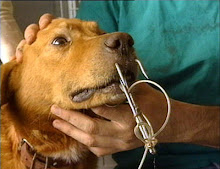Former Pets End Up Dead in University Teaching Labs
Investigation Reveals Supply Line of Dogs and Cats in Higher Education
JENKINTOWN, Pa., April 27 /PRNewswire-USNewswire/ -- A new report, "Dying to Learn: Exposing the Supply of Dogs and Cats to Higher Education," documents the hidden practices of higher education, proving that science lab students are using former pets at major colleges and universities. It traces the route that brings dogs like Cruella, a shepherd-mix from Michigan, to an unhappy end, a victim of dissection, live surgeries and other procedures, at college and university teaching labs. The report is available at www.dyingtolearn.org.
"Dying to Learn: Exposing the Supply and Use of Dogs and Cats in Higher Education" is the result of a two-year investigation of animal acquisition and use from 92 public colleges and universities in the U.S. It presents evidence of unnecessary use of animals, unethical sources, and chronic violations of animal dealers supplying dogs and cats to these institutions.
A comprehensive review of official documents reveals that 52% of the colleges and universities examined are using live and dead dogs and cats for teaching and training purposes in life science, veterinary, and medical education, in spite of viable alternatives available that are being used by other schools.
All categories of animal dealers supplying dogs and cats to public colleges and universities have track records of violations of the federal Animal Welfare Act (AWA), which regulates the care and use of animals supplied and used in laboratories and other industries. These violations include inhumane treatment.
Of particular concern are the cats and dogs purchased from random source Class B animal dealers who collect animals from shelters and pounds, misleading ads, auctions, and other sources. The United States Department of Agriculture (USDA) admitted in its 2007 Animal Welfare Report that "some of these dealers may be trafficking in stolen animals."
Tracie Letterman, Esq., Executive Director of the American Anti-Vivisection Society (AAVS), commented, "Congress should act to cut off the supply of pets to labs by banning random source Class B dealers and the use of random source animals in general. Immediate action could be taken by USDA, which has the discretion not to renew licenses for those random source Class B dealers who are consistently violating the AWA."
Animalearn Director Laura Ducceschi also expressed concern about those colleges and universities that obtain cats and dogs directly from local pounds and shelters. "With the current economic and foreclosure crisis causing homeowners across the country to lose their homes, the numbers of pets being relinquished to shelters is drastically increasing, putting an ever-increasing number of former pets at risk of ending up in labs. That kind of fate is completely at odds with recent studies showing that 65% of Americans consider the welfare of pets 'very important'."
Dying to Learn, which was released today by Animalearn, the education division of AAVS, also documents problems with other sources of dogs and cats, such as biological supply companies, who sell preserved animals, and Class A dealers, who breed animals on their premises.
The report has some good news however. It offers extensive resources, including studies showing that students learn as well or better with cost-effective humane alternatives and/or therapeutic uses of animals. These include beneficial shelter medicine programs for veterinary students, ethically sourced animal cadavers, virtual dissection, and technologically advanced surgical simulations.
Animalearn, the educational division of the American Anti-Vivisection Society (AAVS), works with educators, students and others to achieve quality humane science education without harmful use of animals. Visit www.animalearn.org.
The American Anti-Vivisection Society has monitored the use of animals in science since it was founded in 1883.
Monday, April 27, 2009
Subscribe to:
Post Comments (Atom)

















No comments:
Post a Comment